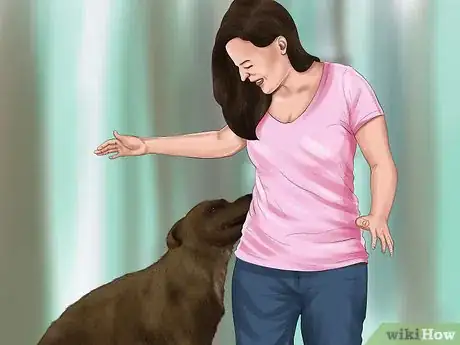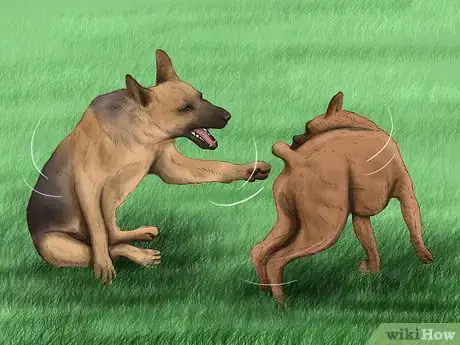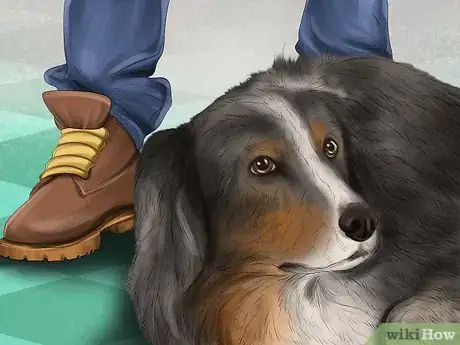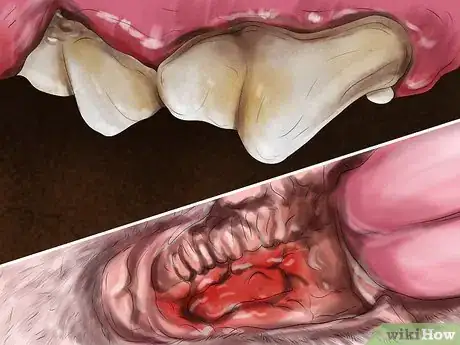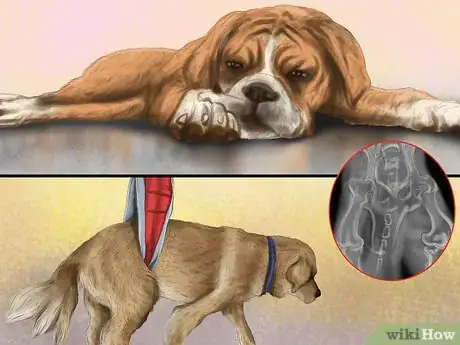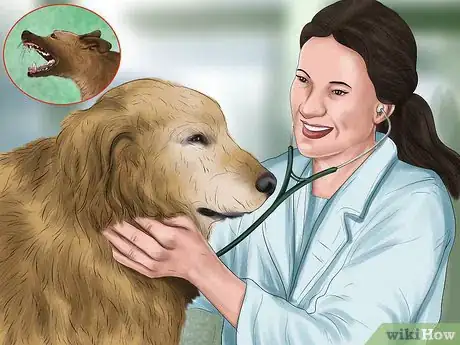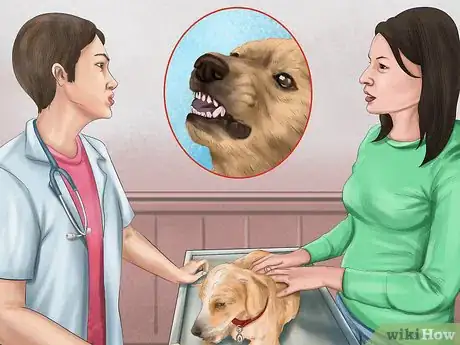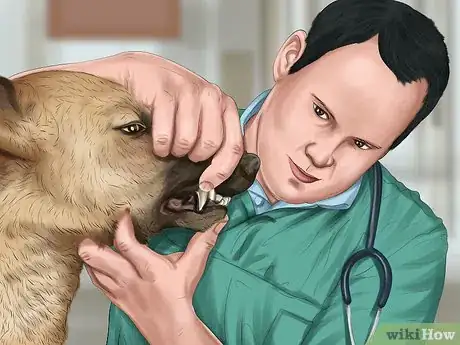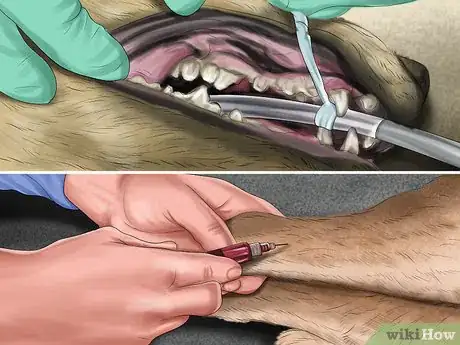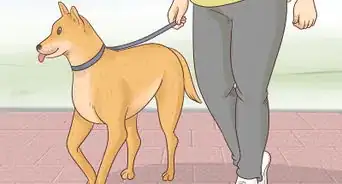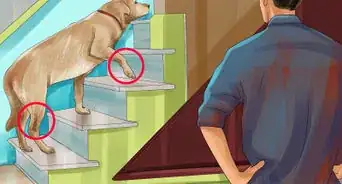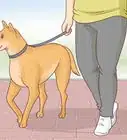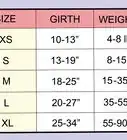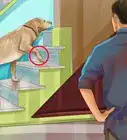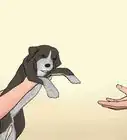This article was co-authored by Lauren Baker, DVM, PhD. Dr. Lauren Baker is a Veterinarian and Assistant Scientist at the University of Wisconsin-Madison. With over 10 years in veterinary medicine, she specializes in the concept of “one health,” which uses insights from veterinary medicine to help human medical research. She holds a Ph.D. in Comparative Biomedical Sciences, a Doctor of Veterinary Medicine, an MS in Comparative Biomedical Sciences, and a Bachelor’s degree in Psychology from the University of Wisconsin-Madison.
This article has been viewed 46,691 times.
Dogs display aggression to express their emotions, especially when they feel like they're being threatened. Aggression consists of a range of behaviors, including growling, snarling, nipping, and even biting. It is a common issue in older dogs and can have different causes, such as hearing and vision loss, lack of mobility, and pain.[1] If your dog has become aggressive in its old age, try to determine what triggers the aggression and take your dog to your vet for a diagnosis of aggression.
Steps
Observing Your Dog's Aggression
-
1Detect aggression with unfamiliar people or pets. Older dogs do not always adjust well to change. If you bring unfamiliar people or pets around your older dog, it could become very anxious and display aggression toward that person or pet.[2]
- Dogs with dementia (canine cognitive dysfunction) have trouble recognizing familiar faces. If your dog has dementia, it could become aggressive toward familiar people or pets because it can't remember who they are.
- Other signs of dementia may include vocalizing (barking, growling, howling, etc.) for no reason, seeming to get lost in familiar rooms, or getting lost or confused in corners.
-
2Watch how your dog interacts with other dogs. Aggression in older dogs can occur in multi-dog households. If your dogs are of different ages, the younger one may start challenging the dominance of the older one. In turn, the older dog may be aggressive toward the younger dog to try to maintain its dominant position.
- Aggression can also occur between older and younger dogs because the older dog is no longer clearly communicating with the younger dog, possibly because it's physically unable to do so. Without proper social signals, aggression could occur between the dogs.[3]
Advertisement -
3Notice if your dog becomes easily startled. Older dogs that have lost their vision and/or hearing receive less sensory input from their environment, meaning they're less aware of what's going on around them. For example, if your dog can't hear very well, it won't know when someone is approaching it. This can startle your dog and trigger aggression.
- If your dog can't see, but can still hear, it may become startled when it hears a sound but can't tell where it's coming from.
- An older dog with hearing and vision loss can become even more startled, leading to aggression.
- To test your dog's ability to see, drop a cotton ball (or other very light, but easy to see object) near your dog. Drop the item just to the side of where your dog's eyes are directed. If your dog can see, then he will look at the cotton ball as it falls. If not, then he will not look or will not seem to notice.
- To test your dog's ability to hear, clap your hands a few times while standing behind your dog, or making another unexpected noise when you are certain that he can't see you. If your dog can hear, then he will turn to see where the noise is coming from. If he does not turn, then he probably cannot hear the sound.
-
4Look in your dog's mouth. Pain can cause an older dog to become aggressive, due to irritability from the pain. Dental disease can be very painful and is a common underlying health problem related to aggression in older dogs.[4] If your dog will allow you, look in its mouth for signs of dental disease:[5]
- Bad breath
- Gingivitis (red, irritated gums)
- Bleeding from the mouth
- Loose, cracked, or missing teeth
- Plaque buildup on the teeth
-
5Observe your dog's ability to move. As dogs get older, their joints can become stiff and painful, making movement difficult. If your dog can't move away from a situation it finds threatening or annoying, it may respond by becoming aggressive.[6]
- Take notice if your dog has trouble standing up after lying down, or can't move up and down the stairs like it used to.
- In addition to making movement difficult, arthritis can be very painful. If your dog has painful arthritis, it may display aggression to avoid being touched.[7]
Seeking a Professional Diagnosis
-
1Take your dog to your vet. It can be hard to see your older dog become aggressive. Before the aggression can be treated, though, its cause needs to be identified.[8] Your vet will examine your dog, get a history from you, and perform diagnostic tests to determine what's causing the aggression.
-
2Tell your vet about your dog's aggression. Because aggression in older dogs can have many different causes, your vet will need detailed information about your dog's aggressive behavior. During the appointment with your vet, include the following information about the aggression:
- When the aggression started
- What the aggression looks like (snarling, growling, baring teeth, nipping)
- When the aggression occurs (meeting new people, interacting with other dogs, when you try to touch your dog)
- Any aggression problems when your dog was younger, and if those problems were treated
-
3Have your vet examine your dog. Your vet will do a physical exam of your dog, looking for any physical problems that could be causing your dog's aggression. For example, your vet will look in your dog's mouth for signs of painful dental disease and check your dog's joints for arthritis.
- Your vet will also perform a neurologic exam to determine if your dog has a neurologic disease, such as dementia, that could be causing the aggression.[9]
- Your vet may also conduct tests to assess vision and/or hearing loss in your dog.
- If your dog is in a lot of pain, your vet may want to briefly sedate your dog so they can examine your dog's mouth and joints more safely.
-
4Allow your vet to perform diagnostic tests. Based on the physical exam findings and the information you provided, your vet may want to perform additional diagnostic tests. If your dog's joints seemed stiff, your vet may recommend x-rays to take a closer look at the joints.
- If your dog's mouth looked unhealthy, dental x-rays would help your vet determine the extent of dental disease.
- Blood work may also help your vet determine if an underlying health problem is causing the aggression.
-
5Visit an animal behavior expert. If a medical problem is not causing your older dog's aggression, then a behavioral issue could be the cause. Your vet may refer you to a qualified animal behavior expert who can conduct a more detailed behavioral assessment of your dog.
- Animal behavior experts have various qualifications, including Certified Applied Animal Behaviorist and board certification in veterinary behavior.[10]
- Use the website http://iaabc.org/consultants to find a qualified animal behaviorist in your area.
Warnings
- Aggression in older dogs can be dangerous, especially if it escalates to biting or causing serious injury to a person or another animal.⧼thumbs_response⧽
References
- ↑ http://www.scamperingpaws.com/seniors/aggressiveseniordogs.shtml
- ↑ http://www.aspca.org/pet-care/dog-care/common-dog-behavior-issues/behavior-problems-older-dogs
- ↑ http://www.flvetbehavior.com/cognitive-dysfunction-in-dogs.html
- ↑ http://www.peteducation.com/article.cfm?c=2+2110&aid=616
- ↑ http://www.vohc.org/perio.htm
- ↑ http://www.peteducation.com/article.cfm?c=2+2110&aid=616
- ↑ http://www.scamperingpaws.com/seniors/aggressiveseniordogs.shtml
- ↑ http://www.aspca.org/pet-care/dog-care/common-dog-behavior-issues/behavior-problems-older-dogs
- ↑ http://www.peteducation.com/article.cfm?c=2+2110&aid=616
About This Article
To find the cause of aggression in an older dog, observe how it behaves around unfamiliar people or pets. If it acts aggressive, it could be because it feels anxious around unfamiliar things. Also, keep an eye out for signs that your dog is in pain, like if it has trouble eating or standing up, which could be the cause of its aggression. Alternatively, if your dog is easily startled, it may have lost some of its vision or hearing, so approach your dog slowly from the front to avoid upsetting it. To learn how to find an animal behavior expert to help your older dog’s aggression, keep reading!
